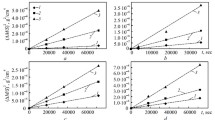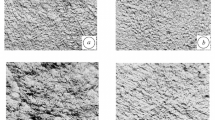Abstract
The electrolytic hydrogen pickup of commercial VT1-0 titanium in recrystallized or submicro-crystalline states leads to the formation of a thin hardened layer, which affects the macromechanical characteristics of the material. After short-term hydrogen pickup, both the strength characteristics and plasticity of the specimens under tension increase simultaneously. This phenomenon is explained by the barrier mesoeffect of the surface hardened layer, which retards the macrolocalization of strain in a loaded specimen and its subsequent fracture. As the time of hydrogen treatment grows, the strength characteristics and plasticity of titanium decrease due to the embrittlement of the surface hydrogenated layer.
Similar content being viewed by others
REFERENCES
V. N. Ageev, I. N. Bekman, O. P. Burmistrova, et al., Interaction of Hydrogen with Metals [in Russian], Nauka, Moscow (1987).
H. Baumbach, M. Krening, Yu. I. Tyurin, et al., Nonequilibrium Systems Metal-Hydrogen. Titanium and Stainless Steel [in Russian], Izd. Tomskogo Universiteta, Tomsk (2002).
A. V. Panin, V. E. Panin, Yu. I. Pochivalov, et al., “Specific features of the localization of strain and the mechanical behavior of VT1-0 titanium in different structural states,” Fiz. Mezomekhanika, 5, No.4, 73–84 (2002).
W. D. Nix, “Elastic and plastic properties of thin films on substrates: nanoindentation techniques,” Mater. Sci. Eng., Ser. A, 234–236, 37–44 (1997).
W. Oliver and G. Pharr, “An improved technique for determining hardness and elastic modulus using load and displacement sensing indentation experiments,” J. Mater. Res., 7, No.6, 1564–1583 (1992).
S. Suresh, T.-G. Nieh, and B. W. Choi, “Nano-indentation of copper thin films on silicon substrates, ” Scripta Mater., 41, No.9, 951–957 (1999).
Ya. L. Giller, Tables of Interplanar Spacings [in Russian], Vol. 1, Nedra, Moscow (1966).
L. I. Mirkin, Handbook on X-Ray Diffraction Analysis of Polycrystals [in Russian], Gos. Izd. Fiz.-Mat. Lit., Moscow (1960).
G. Alefeld and J. Volkl (editors), Hydrogen in Metals, Vol. 1: Basic Properties, Springer, Berlin (1978).
A. V. Panin, V. E. Panin, I. P. Chernov, et al., “Effect of the state of the surface of submicrocrystalline titanium and α-iron on their deformation and mechanical properties,” Fiz. Mezomekhanika, 4, No.6, 87–94 (2001).
V. E. Egorushkin, “Dynamics of plastic deformation. Waves of localized plastic deformation in solids, ” in: V. E. Panin (editor), Physical Mesomechanics and Computer-Aided Design of Materials [in Russian], Vol. 1, Nauka, Novosibirsk (1995), pp. 50–77.
Author information
Authors and Affiliations
Additional information
__________
Translated from Fizyko-Khimichna Mekhanika Materialiv, Vol. 40, No. 6, pp. 41–48, November–December, 2004.
Rights and permissions
About this article
Cite this article
Panin, A.V. Mechanical Behavior of Hydrogenated Commercial VT1-0 Titanium. Mater Sci 40, 756–763 (2004). https://doi.org/10.1007/s11003-005-0112-z
Received:
Published:
Issue Date:
DOI: https://doi.org/10.1007/s11003-005-0112-z




